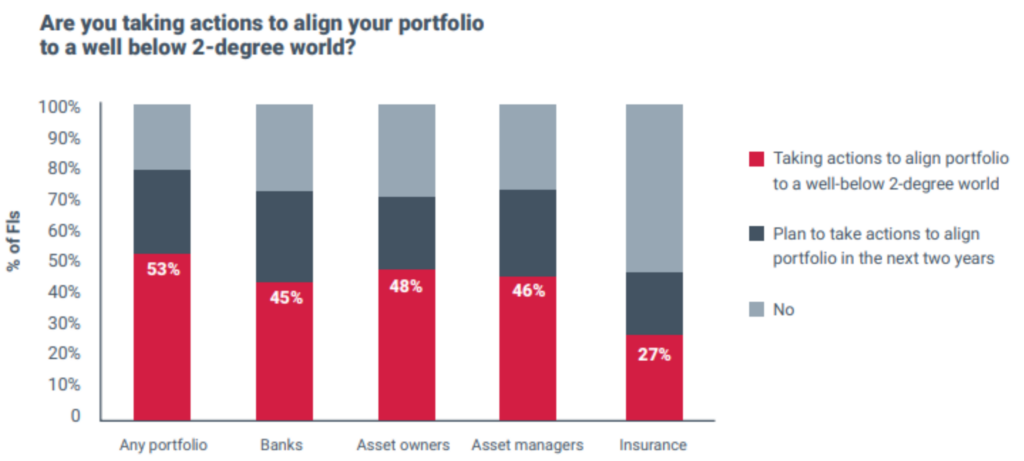Sustainability Monitoring in Financial Services
The economic cost of extreme weather is growing exponentially, with the U.S. NOAA (National Oceanic and Atmospheric Administration) estimating that physical disasters in the U.S. cost $145 billion in 2021, 40% higher than the $102 billion in 2020. Of particular interest for corporations and governments is their exposure to physical climate risks like flood, drought, and forest fires. These risks can not only threaten a company’s physical assets but also their supply chains, operations and customers.
Financial Services at High Risk
Early adopters of climate risk analytics are financial service institutions including insurance underwriters and asset managers, as the sector holds up to 80% of climate-related losses at risk (CDP, 2019). This reality has kickstarted a shift to financial services seeing climate risk as a financial risk, just like geopolitics or low credit scores, rather than just a reputational risk.
In realizing the high climate risks of their investments and insureds, financial services companies are also demanding high granularity climate risk data from their portfolio companies.
A 2017 report by the CDP found that only 100 companies were responsible for almost 70% of global GHG (greenhouse gas) emissions, most of which were oil and gas or mining companies. From these 100 companies, 41% were investor-owned, highlighting the high number of financed emissions.
Financed emissions are carbon emissions related to financial services and activities including underwriting, investment, and lending. Financed emissions are large, underreported and misaligned with public commitments to reduce emissions. In response:
- Investors are demanding companies in their portfolios disclose their emissions to better understand their own financed emission data and meet their own sustainability goals.
- Governments are also mandating climate-related financial risk disclosures from financial services firms. If investors have access to complete, comparable and reliable climate-related information from companies, financial flows can be directed towards more sustainable investments. Governments also want to reduce the economic impact of climate change.
- Banks and asset managers have signed up to commitments to reduce emissions such as The Net Zero Asset Managers Initiative and the Glasgow Financial Alliance for Net Zero (GFANZ).
In April 2021, the CDP analyzed financed emissions in the financial services sector. Based on self-reported data, they found:
- Financed emissions are on average 700 times larger than direct emissions.
- Even given this, less than half of banks (45%), asset owners (48%), asset managers (46%) and insurers (27%) are currently acting to align investment or underwriting portfolios with a well below 2-degree goal (Figure 1).
- Half of the 84 organizations which reported, holding $27 trillion in assets, included less than 50% of their portfolios in their financed emissions reporting.
- However, over 80% of financial institutions surveyed are using or plan to use climate-related scenario analysis to inform their strategy (Figure 2).


Financial Services companies have been on the forefront of developing frameworks for the sector which have ultimately been included in regulation across the globe and used by sustainability monitoring services and technology providers:
- Carbon: The Task Force on Climate-related Financial Disclosures (TCFD) created a widely adopted emissions disclosure framework for financial services, including recommendations of governance, strategy, risk management, metrics and targets.
- Regulators in the U.S. and UK have used the TCFD framework for mandatory disclosure regulations.
- Newer frameworks have been launched to calculate financed emissions, not just financed risk, including the Partnership for Carbon Accounting Financials (PCAF).
- Nature: In April 2022, the new draft Taskforce for Nature-Related Financial Disclosures (TNFD) was launched and builds on the TCFD model in anticipation of nature-based disclosure regulation.
- These frameworks mostly focus on environmental risks to a company’s bottom-line over their environmental impact.
- Higher percentages are reporting on risks and opportunities over quantifiable metrics and targets (Figure 3). Financial Services institutions can therefore appear to act on climate change while just avoiding risks, leading to greenwashing.

We expect to see more frameworks launched for additional metrics including supply-chain risks, circularity, and resources.
Innovators in Financial Services
Methodologies and technologies to monitor climate risks and emissions which originated from financial services are serving as a model across other industries. Innovators are specializing products for the financial services sector, addressing climate risk assessments and financed emissions calculations.
Some innovators have specialized their products specifically to address the needs of these industries, especially financed emissions.
- SINAI’s tools enable companies to perform scenario analyses and evaluate mitigation opportunities to create an actionable decarbonization strategy. An organization can quantify and report on achievable emissions targets, dynamic carbon budgets, and sustainable internal carbon pricing measures, and can automate GHG inventories using custom emission factors for the finance industry.
- Persefoni’s mantra is that when you are managing capital day to day, you don’t have the time to become a carbon accounting expert. The company excels in helping to answer the question, “What are the emissions associated with my investment portfolio,” and empowers you with insights on the largest contributors to your carbon footprint by asset class, fund, strategy, or industry.
Investors are looking for quick tools to manage environmental investment risks. The Environmental Social and Governance (ESG) ratings market is complex and controversial. Most ESG ratings, however, provide a score for corporates on how their corporate commitments, performance, business models and structures align with sustainability, social and governance goals, based on different ESG criteria. ESG ratings will be covered in more depth in an upcoming Perspective.



